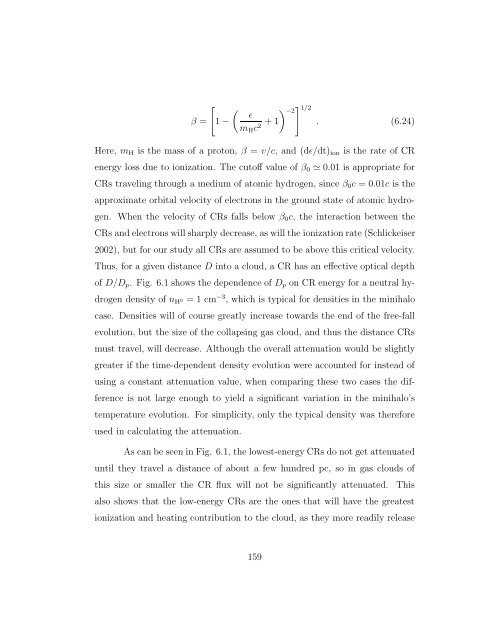Copyright by Athena Ranice Stacy 2011 - The University of Texas at ...
Copyright by Athena Ranice Stacy 2011 - The University of Texas at ...
Copyright by Athena Ranice Stacy 2011 - The University of Texas at ...
Create successful ePaper yourself
Turn your PDF publications into a flip-book with our unique Google optimized e-Paper software.
β =<br />
<br />
1 −<br />
<br />
−2<br />
1/2<br />
ɛ<br />
+ 1<br />
mHc2 . (6.24)<br />
Here, mH is the mass <strong>of</strong> a proton, β = v/c, and (dɛ/dt)ion is the r<strong>at</strong>e <strong>of</strong> CR<br />
energy loss due to ioniz<strong>at</strong>ion. <strong>The</strong> cut<strong>of</strong>f value <strong>of</strong> β0 0.01 is appropri<strong>at</strong>e for<br />
CRs traveling through a medium <strong>of</strong> <strong>at</strong>omic hydrogen, since β0c = 0.01c is the<br />
approxim<strong>at</strong>e orbital velocity <strong>of</strong> electrons in the ground st<strong>at</strong>e <strong>of</strong> <strong>at</strong>omic hydro-<br />
gen. When the velocity <strong>of</strong> CRs falls below β0c, the interaction between the<br />
CRs and electrons will sharply decrease, as will the ioniz<strong>at</strong>ion r<strong>at</strong>e (Schlickeiser<br />
2002), but for our study all CRs are assumed to be above this critical velocity.<br />
Thus, for a given distance D into a cloud, a CR has an effective optical depth<br />
<strong>of</strong> D/Dp. Fig. 6.1 shows the dependence <strong>of</strong> Dp on CR energy for a neutral hy-<br />
drogen density <strong>of</strong> nH 0 = 1 cm−3 , which is typical for densities in the minihalo<br />
case. Densities will <strong>of</strong> course gre<strong>at</strong>ly increase towards the end <strong>of</strong> the free-fall<br />
evolution, but the size <strong>of</strong> the collapsing gas cloud, and thus the distance CRs<br />
must travel, will decrease. Although the overall <strong>at</strong>tenu<strong>at</strong>ion would be slightly<br />
gre<strong>at</strong>er if the time-dependent density evolution were accounted for instead <strong>of</strong><br />
using a constant <strong>at</strong>tenu<strong>at</strong>ion value, when comparing these two cases the dif-<br />
ference is not large enough to yield a significant vari<strong>at</strong>ion in the minihalo’s<br />
temper<strong>at</strong>ure evolution. For simplicity, only the typical density was therefore<br />
used in calcul<strong>at</strong>ing the <strong>at</strong>tenu<strong>at</strong>ion.<br />
As can be seen in Fig. 6.1, the lowest-energy CRs do not get <strong>at</strong>tenu<strong>at</strong>ed<br />
until they travel a distance <strong>of</strong> about a few hundred pc, so in gas clouds <strong>of</strong><br />
this size or smaller the CR flux will not be significantly <strong>at</strong>tenu<strong>at</strong>ed. This<br />
also shows th<strong>at</strong> the low-energy CRs are the ones th<strong>at</strong> will have the gre<strong>at</strong>est<br />
ioniz<strong>at</strong>ion and he<strong>at</strong>ing contribution to the cloud, as they more readily release<br />
159









